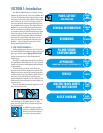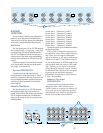
10
SOLO SOLO SOLO SOLO SOLO SOLO SOLO SOLO
MONO
L+R
RLRLRLR
dB
30
20
10
OO
10
40
50
dB
30
20
10
OO
10
40
50
dB
30
20
10
OO
10
40
50
dB
30
20
10
OO
10
40
50
dB
30
20
10
OO
10
40
50
dB
30
20
10
OO
10
40
50
dB
30
20
10
OO
10
40
50
dB
30
20
10
OO
10
40
50
dB
30
20
10
OO
10
40
50
dB
10
10
20
30
40
50
OO
MONO
L+R
MONO
L+R
MONO
L+R
MONO
L+R
ASSIGN
MONO
L+R
MONO
L+R
1
L
2345678
MONO
L+R
ASSIGN ASSIGN ASSIGN ASSIGN ASSIGNASSIGNASSIGN
5
5
5
5
5
5
5
5
5
5
5
5
5
5
5
5
5
5
5
5
LEFT/RIGHT
MIX
MIX
MIX MIX MIX
UUUUUUUU U
U
80 80 80 80 80 80 80 80 80 80
TALKBACK
MIC
OUTPUT SECTION
The output section is the large area to the right of
the input channel strips. It contains the master fad-
ers and metering, as well as the send and return
masters, cue, monitoring and communication
controls.
8•BUS FADERS
At the bottom of the output panel are the mas-
ter faders for each of the eight buses (1). Each
fader controls the level of its mix, with precise dB
markings and a unity gain point marked on the
panel. The fader is located in the circuit after the
submaster insert jack but before the final line
amplifier.
There is an Assign section associated with each
bus fader, detailed below. Note that no matter
what the selection of the assignment switches, the
output of each bus is always present at its Sub-
master/Tape Output jack and is monitored on its
own bus meter.
L MIX and R MIX
The odd-numbered buses have an L MIX but-
ton above their faders (2); the even buses have an
R-MIX button (3). Pressing this button assigns
the bus to the L or R Mix bus, respectively. This
switch, along with the MONO L & R switch dis-
cussed below, allows you to assign submix buses
within your L/R mix.
MONO L & R
The MONO L & R switch (4) functions ONLY
when you have first depressed the L MIX or R
MIX. If you’ve pushed L MIX or R MIX, pushing
MONO L & R will assign the bus to both channels
of the Left and Right Mix buses, instead of just the
Left, or just the Right. This is also for submixing,
but allows you to put your submix in the center
rather than on either side.
(Those of you with patch
cords have probably realized
you can patch the bus into a
channel and do even more
fun things, but we’ll talk
about that later.)
SOLO
The SOLO button (5) solos the output of the bus
fader. When any SOLO button is pressed, the SOLO
LED lights.
This is a pretty trick SOLO, too. If you have not
pushed the MONO L & R switch, the SOLO sends the
odd-numbered tracks to the left speaker and the
even-numbered tracks to the right, whether or not
the associated L MIX or R MIX is engaged. But if you
have pressed MONO L & R,
the SOLO circuit is smart
enough to send the bus to
both speakers and put the
stereo image in the middle.
You will be the envy of your
neighborhood.
L/R MIX FADER
The L/R MIX fader (6) is
a stereo fader located at the
far right of the console. The
fader controls the level of
the L/R MIX bus, with pre-
cise dB markings and a
unity gain point marked on
the panel. This fader, like
the bus faders, is located in
the circuit after the L/R in-
sert jack but before the final
line amplifier.
LAYOUT
AND
FUNCTION


















